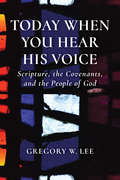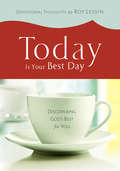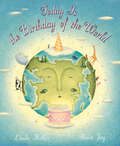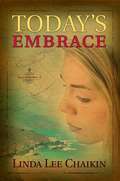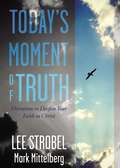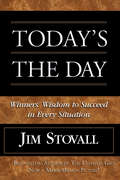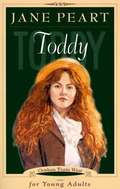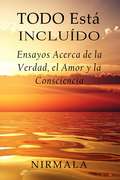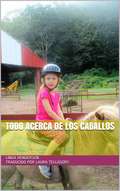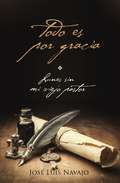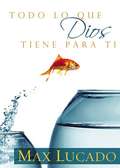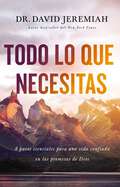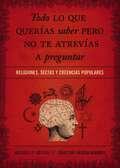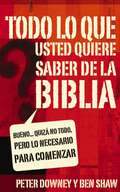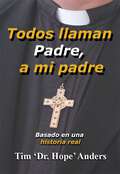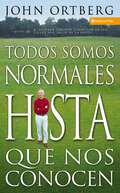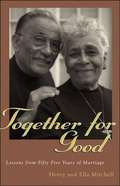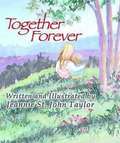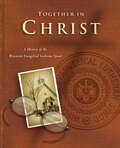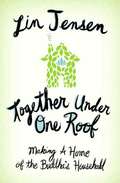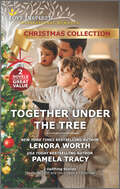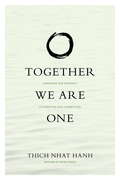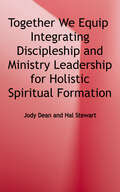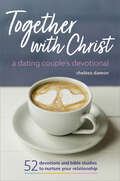- Table View
- List View
Today When You Hear His Voice: Scripture, the Covenants, and the People of God
by Gregory W. LeePresents a doctrine of Scripture based on Hebrews in dialogue with Augustine and Calvin What vision of biblical authority arises from Scripture&’s own use of Scripture? This question has received surprisingly little attention from theologians seeking to develop a comprehensive doctrine of Scripture. Today When You Hear His Voice by Gregory W. Lee fills this gap by listening carefully to the Epistle to the Hebrews. Lee illuminates the unique way that Hebrews appropriates Old Testament texts as he considers the theological relationship between salvation history and scriptural interpretation. He illustrates these dynamics through extended treatments of Augustine and Calvin, whose contrasting perspectives on the covenants, Israel, and the literal and figural senses provide theological categories for appreciating how Hebrews innovatively presents Scripture as God&’s direct address in the contemporary moment.
Today is Your Best Day
by Roy LessinCan terminal cancer, divorce, abuse, miscarriage, bankruptcy and other traumatic events keep you from having your best day? Best-selling author and co-founder of DaySpring, Roy Lessin helps you focus your thoughts on what really matters - your relationship with God through Christ Jesus. Today IS your best day Because Christ is in you Because of God's presence Because of Jesus' name Because of the Cross And 56 more compelling reasons Start your day with these encouraging truths. Walk in the assurance of what your heart knows, not the uncertainty of what your eyes see. Terminal cancer patient, Lawrence Knorr decided to make every day for the rest of his life the best of his life. He and his wife Linda read Today is Your Best Day each day six times through. They were so encouraged by the book they shared it with over 400 families before Jim left this world for heaven. In the foreword of this printing, Linda asks that we honor Jim by sharing this book and letting God use each of us to enrich the lives of others. Click here to read her foreword, view the table of contents and read the first chapter.
Today is the Birthday of the World
by Linda HellerToday is a special day: the birthday of the world, when God and all God&’s creatures celebrate the beauty of life. As God asks each dear creature in turn whether it has been the best that it can be, this simple affirmation of life and goodness applauds the contribution that each and every one of us— from the mightiest elephant to the smallest child— can make. The whimsical animals in Alison Jay&’s perfectly composed crackled paintings will make this a favorite book on the family shelf.
Today's Embrace (East of the Sun)
by Linda Lee ChaikinShe gambled with her husband's trust. At stake is-everything. Evy Varley's marriage to Rogan Chantry is all she had hoped it would be-until she finds out that she is pregnant with a honeymoon baby. Fearing that Rogan won't allow her to travel while she is expecting, Evy plots to keep her pregnancy secret in order to accompany him to South Africa. Her thoughts are not only for her husband, but Evy is determined to travel to Bulawayo, the new mission station of Dr. Jakob van Buren-the one man who can help Evy to finally clear her mother's name. After she and Rogan set out to sea, however, Evy discovers that she has gone too far in her deceit, and the damage to her marriage may be irreversible. Matters only worsen in Africa, where malaria, murder, and an African uprising all take their toll-and where Rogan and Evy must fight not only for their love, but also for their very lives.From the Trade Paperback edition.
Today's Moment of Truth: Devotions to Deepen Your Faith in Christ
by Lee Strobel Mark MittelbergWhy do you believe what you believe? How can you know your faith is credible?Many Christians today struggle to answer these questions. Though you may know what you believe, the why and how behind the thought can be complex, confusing, and even mysterious.In Today’s Moment of Truth, bestselling author Lee Strobel articulates in 180 easy-to-read devotions the reasons why Christians believe what they believe. Combining his expertise in apologetics with his journalistic approach to parsing out the details, this devotionalwill leave you deeply encouraged and well-informed. Topics range from scientific discoveries to theological explanations, and each devotion is followed by a brief reflection and prayer for meditation.The time has come to walk confidently in your faith. Today’s Moment of Truth will be an invaluable tool as you grow in your understanding of and faith in Christ.
Today's the Day!
by Jim StovallBy picking up this book, you have already taken a first step toward succeeding in life. But will you take the next step. and the next? Will today be the day you finally resolve to do something positive with your life-no matter what difficulties you face?The world is made up of all kinds of people in all sorts of circumstances. But ultimately, everyone falls into one of two categories: winners or losers those who succeed. and those who fail. Nobody sets out to lose fail. But often we don't really know what success means, or how to achieve it personally. Now there's help. In this inspiring and uplifting book, Jim Stovall shares easy-to-read, easy-to-put-to-work nuggets of wisdom that he has learned personally by overcoming his own blindness and becoming one of America's most accomplished entrepreneurs. Each persuasive chapter gives you a practical, positive, powerful insight that can help you successfully negotiate every situation in your life.Ready to get started learning the winner's ways of success? Today's the Day!
Toddy (Orphan Train West)
by Jane PeartAfter her mother leaves six year old Toddie at the county children's home,she is chosen by a minister's wife to go west on the Orphan train and is taken in by a wealthy widow as a companion for her sickly granddaughter.
Todo Está Incluído: Ensayos Acerca de la Verdad, el Amor y la Consciencia
by Nirmala Sandra Morales KottLa unidad no es sólo una experiencia profunda y muy personal que te cambia la vida, sino también una perspectiva que puede transformar el mundo trayendo más amor, luz, compasión y verdad a él. La Unidad nos conecta a todos. Nos estamos afectando unos a otros en todo momento, y reconocer esto a cualquier grado posible es transformador. Todo está incluido en esta unidad, a la que señalan todos los maestros espirituales y líderes iluminados. Abrazando todo con una actitud de su valor esencial, podemos ir más allá de las ilusiones de separación hacia un descanso en la belleza y misterio de toda la realidad. Este libro es una colección de artículos y ensayos, los cuales contínuamente apuntan a esta unidad y a todo lo que está incluído en la vida. En él, encontrarás respuestas a muchas preguntas comunes planteadas por buscadores, que te ayudarán en la búsqueda de paz, amor y comprensión. En estos ensayos aprenderás: • Cómo saber directamente cuán verdadero es algo para tí • Cómo dar amor incluso cuando no te agrada alguien • Tips para practicar la Auto-Indagación • La simple verdad acerca del sufrimiento y cómo sanarlo • Cómo entrar en la Presencia y permanecer ahí • Cómo superar malos hábitos y adicciones • La riqueza inherente del vacío y el espacio Nota del autor: Este libro es una colección de artículos y ensayos que cubren muchos temas diferentes que han brotado en los casi veinte años que, como maestro y mentor espiritual, he compartido perspectivas acerca de nuestra naturaleza espiritual. También he incluído dos apéndices, "La Sabiduría del Corazón" y "Amor es Dar" que son extractos de mi libro Vivir Desde el Corazón. Estos apéndices contienen perspectivas que he estado compartiendo por años y recomiendo que quien no esté familiarizado con estas escrituras anteriores las visiten para proveer una base que les sirva en lo que s
Todo acerca de los caballos
by Linda Henderson"Todo acerca de los caballos" te contará datos interesantes sobre los caballos que quizás nunca habrías conocido. Los niños de entre 6 y 10 años de edad que amen a los caballos, o hayan disfrutado montar un poni en la feria, querrán leer este libro. Incluye también hermosas imágenes sobre las enormes pero amigables criaturas. ¿Sabías que existen más de treinta razas de caballos? Puedes aprender más acerca de varias de ellas en este libro.
Todo es por gracia
by Jose Luis NavajoEl síndrome del agotamiento suele deberse a múltiples causas, y se origina principalmente en profesiones de estrecho contacto con personas, especialmente cuando existe una intensa relación interpersonal.En otras palabras, el ministerio pastoral es una profesión de alto riesgo para este síndrome, por lo que este libro viene a ocuparse de un problema poco tratado, pero que sin duda tiene una alta incidencia entre quienes asumen con seriedad la responsabilidad del ministerio pastoral.Este libro será por ello una herramienta en la que mirarse como en un espejo, y útil para diagnosticar si nosotros mismos o alguien cercano está en el proceso de agotarse espiritualmente.
Todo lo que Dios tiene para ti
by Max LucadoDios hizo solo una versión de ti. Él te diseño para una tarea única. En el estilo que lo caracteriza, Max, captara tu atención, encenderá tu pasión por la vida y te dará un buen comienzo, basado en el plan de Dios para ti como un individuo único. Solo hay uno como tú y Dios te ha escogido para un tarea exclusiva. Puedes ser todo lo que Dios quiere que seas.
Todo lo que necesitas (Everything You Need, Spanish Edition): 8 pasos esenciales para una vida confiada en las promesas de Dios
by Dr David JeremiahMuchos cristianos se sienten poco preparados e inciertos cuando se trata de vivir cada día como seguidores de Cristo. A menudo sabemos lo que se supone que debemos hacer, e incluso por qué se supone que debemos hacerlo. Sin embargo, cuando nos falta confianza en nosotros mismos y en nuestro desarrollo espiritual, no podemos vivir audazmente para marcar la diferencia en nuestro mundo.Como uno de los principales maestros bíblicos del mundo, el Dr. David Jeremiah quiere que los lectores sepan que esta falta de confianza es innecesaria e inútil. De hecho, la Biblia deja claro que, de la misma manera que los excursionistas hábiles empacan todos los suministros necesarios antes de un viaje, Dios mismo equipa a todos los creyentes con todo lo que necesitan para caminar y trabajar con confianza como miembros de su reino.Todo lo que necesita continúa con el enfoque del Dr. Jeremiah de ayudar a la iglesia a luchar por la victoria espiritual a través de Cristo. Utilizando su profundidad, sabiduría y compasión distintivas, el Dr. Jeremiah explora 2 Pedro 1: 5–10 para resaltar siete herramientas críticas que Dios proporciona a cada uno: virtud, conocimiento, dominio propio, perseverancia, piedad, bondad fraternal y amor. Cuando usamos el equipo que Dios proporciona, podemos vivir con confianza sabiendo que nunca tropezaremos.
Todo lo que querías saber pero no te atrevías preguntar: Religiones, sectas y creencias populares
by Jessica Tinklenberg Devega¡Todo lo que necesitas saber sobre las religiones y filosofías del mundo en un práctico libro! Conforme se acortan las distancias en nuestro mundo globalizado, encontramos más religiones y creencias populares que antes. Este libro, escrito por dos profesoras de religión -una de secundaria, la otra universitaria- expone los orígenes, historia, prácticas y creencias de cuarenta grupos. Cada capítulo pone al grupo en contexto y explica en qué se asemeja o diferencia determinada religión con respecto al cristianismo. Ningún otro libro abarca tan amplia variedad de temas, desde el islamismo, chamanismo y mormonismo hasta el ateísmo, vampirismo y la astrología. Algunas características:Tablas y gráficos que facilitan la comparación de las diferentes prácticas y creencias religiosasAbarca religiones mundiales, nuevas religiones y religiones de la cultura popularGeneralidades sobre los orígenes, historia y tipo de seguidores en cada religiónPráctico para el estudio individual o en el aula.
Todo lo que quieres saber de la Biblia: Bueno… quizás no todo, pero lo necesario para comenzar
by Ben James Shaw Peter Douglas Downey¡Es el libro mas vendido de todos los tiempos! Ha sido traducido a más de dos mil idiomas. Ha cambiado la vida de muchas personas alrededor del mundo. No, no es > ¡Es la Biblia! AUNQUE LA BIBLIA muchos la entienden muy bien, realmente no es así; y es una lástima, porque la Biblia es interesante y no debe ser considerada como un misterio. Si eres un nuevo interesado en la Biblia y piensas que el libro de Números es la guía perfecta para aprender matemáticas, que tu oxidado conocimiento sobre la Biblia necesita pulirse, o simplemente deseas una mirada fresca al libro que has leído en tantas ocasiones, este libro es para ti. No es un seco tratado teológico, está escrito en un estilo atractivo que disfrutarás. EN RESUMEN encontrarás capítulos fáciles de leer, autores que responden algunas preguntas básicas como: ¿Quién escribió la Biblia? ¿Es exacta? ¿Cómo orientarse en la Biblia? ¿Cómo metió Noé a todos esos animales en el arca? (bueno, quizá no esa, pero hay bastantes respuestas). También te llevará en un recorrido, desde Génesis hasta Apocalipsis, revelando cosas de la gente, acontecimientos y temas importantes. Tendrás una buena base para entender, y el entusiasmo por leer el más importante de los libros: >
Todos Llaman Padre, A mi Padre
by Tim 'Dr. Hope' AndersBasado en la verdadera historia de amor de la vida de los padres del autor, su madre, una actriz, y su padre, un sacerdote católico. El hijo de un sacerdote católico lo cuenta todo. Esta novela romántica se basa en una verdadera historia de amor: la historia de los padres del autor. El personaje de una joven tenaz, Bouvette Sherwood, que es una exitosa productora y actriz de New York Broadway, conduce la trama. A mediados de la década de 1940, Bouvette se encuentra y se enamora de un alcohólico encantador, Hughie Hewitt. Sin embargo, él tiene un secreto que le oculta durante su intenso noviazgo: es un sacerdote católico. Su historia de amor se desarrolla en un caleidoscopio de intriga, suspenso, traición y romance.
Todos somos normales hasta que nos conocen
by John Ortberg¿Normal? ¿Quién es normal? Es seguro que usted no lo es. Tampoco lo es nadie que conozca. Ninguno de nosotros somos normales de acuerdo con la definición de Dios, y mientras más cerca estemos uno del otro, más evidente se hará esto. Sin embargo, para todas nuestras excentricidades, pecados y exabruptos, nos necesitamos los unos a los otros. Comunidad es más que solo una palabra… es uno de nuestros requerimientos más importantes. Así que ¿cómo pueden las personas con defectos y no normales como nosotros dominar las fuerzas que nos apartan y nos unen en las relaciones transformadoras de vida para las que Dios nos designó? En Todos son normales hasta que los conoces, el profesor y autor de éxitos de ventas, John Ortberg, hace énfasis en aquello que marca nuestra comunidad. Tendrás pensamientos inspiradores al mirar en el corazón de Dios, de los demás y en el tuyo propio. Aún mejor, obtendrás sabiduría y las herramientas para poder acercarte a otros en formas poderosas e impactantes. Con humor, perspicacia y su don para narrar historias, Ortberg muestra cómo la comunidad paga grandes dividendos en felicidad, salud, respaldo y desarrollo. Es ahí cuando todos nosotros, personas extrañas y difíciles de tratar, encontramos el amor de Dios de manera tangible y descubrimos el poder transformador de ser amado, aceptado y valorado justo en la forma que somos.
Together For Good: Lessons from Fifty Five Years of Marriage
by Henry H. Mitchell Ella P. MitchellThe book tells how the Mitchells coped with the first year of marriage, financial problems, the birth and adoption of their children, switching jobs, and moving.
Together Forever
by Jeannie St. TaylorTogether Forever is the touching story of a young girl's sadness over the death of her brother. Full of grief, she dreams of her brother. In the dream her brother helps her to know that heaven is more beautiful and more wonderful than any place on earth. Her brother assures her that he is happy in heaven and will wait to be with her again. She comes to understand that someday they will be together again, forever in heaven. This beautiful book will help comfort children experiencing loss and grief.
Together In Christ
by John A BraunWhat is the Wisconsin Evangelical Lutheran Synod (WELS)?In this book, follow WELS from its humble beginnings as a small seed in the American Midwest to the abundant mission fields worldwide.Together in Christ is a concise history of WELS and focuses on God’s work in the hearts of people who had a great impact in the history of this synod. Their stories are often much like the stories of our own lives, filled with more struggles than glorious triumphs. Yet, through all the struggles, the Lord of the church watched over the synod’s founders and led them forward.Through reading the retelling of these stories, you’ll learn more about the history of the WELS and be reminded that God continues to shape Christians to be his people—his witnesses—in the world!
Together Under One Roof: Making a Home of the Buddha's Household
by Lin JensenIn Together Under One Roof, Lin Jensen turns his keen eye and powerful prose explicitly to the teachings of the Buddha, to traditional Zen stories, and to the practices of meditation and compassion--as well as the intricacies of everyday language and the natural world, truth and beauty, family, and the myriad ways our simplest actions affect our whole lives. His previous two works, memoirs of growing up and growing old and of the hard-won but gentle wisdom gained in his daily public meditations for peace, were both critical successes earning a special place in readers' hearts. This book takes up symphonic variations on one main theme: we are all "in it" together, we are all living under one roof--and there's always a glowing hearth right here in this, the Buddha's household.
Together Under the Tree
by Lenora Worth Pamela TracyA family for Christmas?The Perfect Gift by Lenora Worth When widowed rancher Rory Branagan finds a pretty stranger sleeping on the sofa, his six-year-old wants her to stay. Disoriented after a car accident, Goldie Rios is definitely not staying. Yet when Goldie's family-heirloom locket goes missing, the Branagans spend the holiday season helping her search for it on the farm. In the process, they all might find the perfect gift: a family that feels just right.Once Upon a Christmas by Pamela Tracy Raising three sons and running his ranch keeps single dad Jared McCreedy busy. Becoming involved with single mom Maggie Tate is not on his to-do list. But he needs help dealing with his youngest son's learning difficulties. Maggie doesn't want any romantic complications. The risk of opening her heart is great and she has her daughter to think about. But Christmas is the season for faith and miracles…New York Times Bestselling Author Lenora WorthUSA TODAY Bestselling Author Pamela Tracy2 Uplifting Stories The Perfect Gift and Once Upon a Christmas
Together We Are One
by Thich Nhat Hanh Sister Chan Khong Hilda Gutierez Baldoquin Larry WardAlthough Together We Are One is based on Thich Nhat Hanh's teachings given to Buddhist practitioners of color, readers of all backgrounds and walks of life can appreciate this inspirational and practical guide. In chapters focusing on honoring our ancestors, developing understanding and compassion, and seeing the world in terms of interbeing, Nhat Hanh shows how meditation and the practice of looking deeply can help create a sense of wholeness and connectedness with others. Chapters are interspersed with mindfulness practice exercises and the personal stories of skilled writers, such as Larry Ward (author of Love's Garden), and Sr. Chan Khong (author of Learning True Love). Covering the discovery of a spiritual path, the experience of finding balance, and overcoming obstacles in an unpredictable world, Together We Are One is a valuable addition to the unique expression of Buddhism in the West.
Together We Are One: Honoring Our Diversity, Celebrating Our Connection
by Sister Chan Khong Hilda Gutierez Baldoquin Larry Ward Thich HanhBased on four retreats that Zen Master Thich Nhat Hanh led specifically for people of color, this book is for people of all colors, backgrounds, and experiences who have ever felt excluded or alienated, or anyone concerned with issues of social justice. Although Together We Are One is based on teachings given to Buddhist practitioners of color, readers of all backgrounds and walks of life will find it an inspirational and practical guide.In chapters focusing on honoring our ancestors, developing understanding and compassion, and seeing the world in terms of interbeing, Nhat Hanh shows how meditation and the practice of looking deeply can help create a sense of wholeness and connectedness with others. Chapters are interspersed with mindfulness practice exercises and the personal stories of skilled writers, such as Larry Ward (author of Love's Garden), Sr. Chan Khong (author of Learning True Love), and Rev. Hilda Ryumon Gutierrez Baldoquin (editor of Dharma Color and Culture), about their discovery of a spiritual path, their experience of finding balance, overcoming obstacles in an unpredictable world, and maintaining and sharing insights. Together We Are One is a valuable addition to the unique expression of Buddhism in the West.As in all his writings, Thich Nhat Hanh does not suggest we replace traditional beliefs and customs with Buddhism, but rather emphasizes that a mindful approach to daily life and interactions can help overcome misperception and separation so that we might honor and transcend our differences. Nhat Hanh's primary focus highlights the basic how-to's of Buddhist practice, such as mindful walking and eating, the practice of Looking Deeply, and a never before published multicultural version of the Touching the Earth Ceremony, making them accessible possibilities for a better everyday life. A companion movie to the book, featuring Thich Nhat Hanh's retreat, can be found at www.colorsofcompassionmovie.com
Together We Equip: Integrating Discipleship and Ministry Leadership for Holistic Spiritual Formation
by Jody Dean Hal StewartIn this text, you will discover the biblical foundation for equipping others. Equipping others in ministry is a process you bring with you as the leader! Its both personal and public. Its you as an individual and your church. This book will challenge you to take responsibility to grow spiritually, engage the culture, and share the gospel. Further, you will discover the impact of discipleship in the local church by examining mentoring small groups and preaching as relevant means to equip others. In the later chapters of the book, seasoned church ministry leaders with years of experience in making disciples through equipping ministry of the local church share many practical ways to equip others and lead church ministries: - childrens ministry - youth ministry - collegiate ministry - mens and womens ministry - adult and senior adult ministries. Many ministry leaders do not know how to make disciples. They know, accept, and believe the Great Commission (Matt. 28: 1920). Yet they struggle with practical approaches and methods to carry out a viable equipping ministry. The book will help you elevate the importance of personal growth, making disciples, and assist you to align your age-graded and gender-based ministry leadership development.
Together With Christ: 52 Devotions and Bible Studies to Nurture Your Relationship
by Chelsea DamonStrengthen your relationship and your faith with insightful Bible devotionsLay the foundation for a lifetime of love, faith, and understanding with curated Bible passages for navigating the ups and downs of dating. This couple's devotional features one devotion for each week of the year to inspire discussion between you and your partner and renew your bond with each other and God.Explore a couple's devotional that features:Scripture for everyday life—Each entry in this couple's devotional includes an excerpt from the Bible, followed by stories and thoughtful questions to help both of you communicate, forgive, and grow.Deepen your connection—Apply Scripture to every area of your relationship, delving into topics such as intimacy, family matters, work, money, and more.Commitment activities for couples—Foster your personal values and morals through suggested activities like going to a baseball game, watching the sun rise, or taste-testing local coffee shops.Get closer to each other and to God with this weekly couple's devotional.
